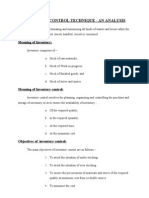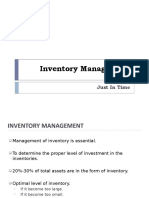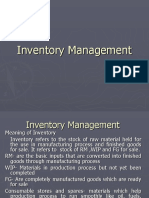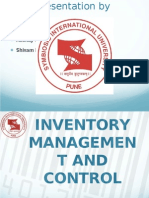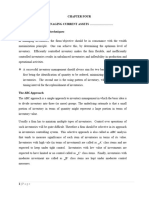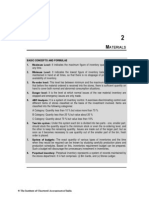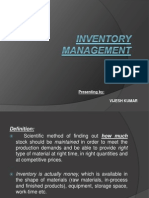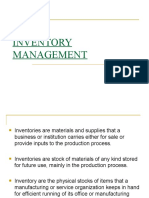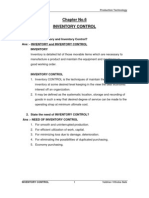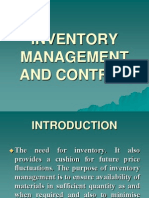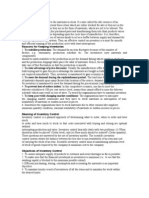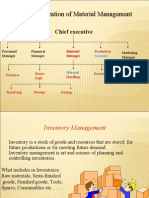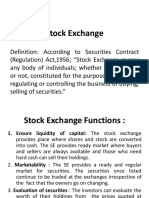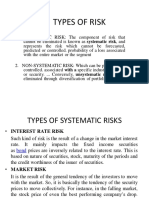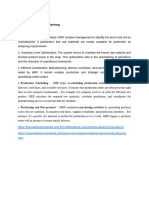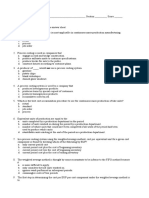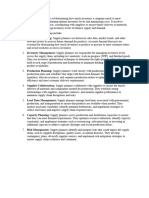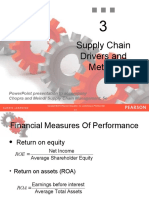0 ratings0% found this document useful (0 votes)
139 viewsUnit 3 Inventory Management
Unit 3 Inventory Management
Uploaded by
Nayan kaki * Annual demand = 50,000 units
* Cost per unit = Rs. 120
* Ordering cost per order = Rs. 45
* Carrying cost percentage = 15%
* Using EOQ formula:
EOQ = √(2AO/C)
Where,
A = Annual demand = 50,000 units
O = Ordering cost per order = Rs. 45
C = Carrying cost percentage = 15%
* Plugging in values:
EOQ = √(2 * 50,000 * Rs. 45 / 15%)
EOQ = √(2 * 50,000 * Rs. 45 / 0.15)
EOQ =
Copyright:
© All Rights Reserved
Available Formats
Download as PPTX, PDF, TXT or read online from Scribd
Unit 3 Inventory Management
Unit 3 Inventory Management
Uploaded by
Nayan kaki0 ratings0% found this document useful (0 votes)
139 views14 pages * Annual demand = 50,000 units
* Cost per unit = Rs. 120
* Ordering cost per order = Rs. 45
* Carrying cost percentage = 15%
* Using EOQ formula:
EOQ = √(2AO/C)
Where,
A = Annual demand = 50,000 units
O = Ordering cost per order = Rs. 45
C = Carrying cost percentage = 15%
* Plugging in values:
EOQ = √(2 * 50,000 * Rs. 45 / 15%)
EOQ = √(2 * 50,000 * Rs. 45 / 0.15)
EOQ =
Original Title
UNIT 3 INVENTORY MANAGEMENT
Copyright
© © All Rights Reserved
Available Formats
PPTX, PDF, TXT or read online from Scribd
Share this document
Did you find this document useful?
Is this content inappropriate?
* Annual demand = 50,000 units
* Cost per unit = Rs. 120
* Ordering cost per order = Rs. 45
* Carrying cost percentage = 15%
* Using EOQ formula:
EOQ = √(2AO/C)
Where,
A = Annual demand = 50,000 units
O = Ordering cost per order = Rs. 45
C = Carrying cost percentage = 15%
* Plugging in values:
EOQ = √(2 * 50,000 * Rs. 45 / 15%)
EOQ = √(2 * 50,000 * Rs. 45 / 0.15)
EOQ =
Copyright:
© All Rights Reserved
Available Formats
Download as PPTX, PDF, TXT or read online from Scribd
Download as pptx, pdf, or txt
0 ratings0% found this document useful (0 votes)
139 views14 pagesUnit 3 Inventory Management
Unit 3 Inventory Management
Uploaded by
Nayan kaki * Annual demand = 50,000 units
* Cost per unit = Rs. 120
* Ordering cost per order = Rs. 45
* Carrying cost percentage = 15%
* Using EOQ formula:
EOQ = √(2AO/C)
Where,
A = Annual demand = 50,000 units
O = Ordering cost per order = Rs. 45
C = Carrying cost percentage = 15%
* Plugging in values:
EOQ = √(2 * 50,000 * Rs. 45 / 15%)
EOQ = √(2 * 50,000 * Rs. 45 / 0.15)
EOQ =
Copyright:
© All Rights Reserved
Available Formats
Download as PPTX, PDF, TXT or read online from Scribd
Download as pptx, pdf, or txt
You are on page 1of 14
UNIT 3 INVENTORY MANAGEMENT
S.E Bolten states, “ The term ‘inventory’ refers to the
stockpile of the product a firm is offering for sale and the
components that make up the product.”
According to the Research Terminology Bulletin, the term
‘inventory’ means “ the aggregate of those items of tangible
personal property which (1) are held for sale in the ordinary
course of business, (2) are in the process of production for
such sale, or (3) are to be currently consumed in the
production of goods or services to be available for sale.”
OBJECTIVES / SIGNIFICANCE OF INVENTORY
MANAGEMENT
The objectives of inventory management may be
discussed under two heads:
(A) Operating Objectives:
(1)Availability of Materials
(2) Minimising the Wastage
(3) Promotion of Manufacturing Efficiency
(4) Better service to customers
(5) Control of Production level
(6) Optimal level of inventories
(B) Financial Objectives
(1) Economy in purchasing
(2) Optimum investment and efficient use of capital
(3) Reasonable Price
(4) Minimising Cost
NEED TO HOLD INVENTORY
1. Production and Sales Motive: Smooth production can be
ensured only when the raw material required for the
production is always available. Similarly, sales can go well if
the concern has sufficient production.
2. Precautionary Motive: It necessitates holding of inventory to
guard against the risk of unpredictable changes in demand
and supply forces.
3. Speculative Motive: It influences the decision to increase or
decrease inventory level to take advantage of price
fluctuations.
INVENTORY CONTROL
Inventory control is concerned with the acquisition, storage,
handling and uses of inventories so as to ensure the
availability of inventory whenever needed, providing
sufficient protection for contingencies, maximising economy
and minimising wastage and losses.The more efficient is the
inventory control, the less is the investment required.
Excessive investment in inventories increases costs and curtail
profits.
OBJECTIVES OF INVENTORY CONTROL
1. To minimise the possibility of delays in
production through supply of raw materials,
stores and spares, tools and other equipments
as an when required.
2. To avoid unnecessary capital being locked
up in inventories.
3. To exercise economies in ordering and
obtaining supplies and storage of materials
INVENTORY COST OR COST OF HOLDING INVENTORIES
1. Inventory Ordering Costs: These costs are known as ‘Set up
costs’ and ‘Acquisition costs’. It is cost of placing an order
and securing the supplies. It includes the use of
stationary,postage,telephone and telegraphs, advertisement etc.
2. Inventory Carrying Costs: Carrying costs are those costs
which are required to be incurred due to inventory storing
,handling,insurance etc. It also includes the interest cost due to
investment being locked up in inventories, rent of the godown,
the salaries and wages of the staff assigned in the duty to look
after the receipt, issue and proper storage of materials etc
3. Stock-out Costs: Stock-out cost is due to the non –stocking of
an inventory.
Essentials of Good inventory control System
1. Classification and identification of Inventories.
2. Standardisation and Simplification of Inventories
3. Adequate Storage facility
4. Setting Minimum and Maximum limits and Reorder Points
for each part of Inventory
5. Fixing Economic Order quantity
6. Adequate Inventory Records and Reports
Modern Techniques of Inventory Control
1. ABC Analysis: It has become an indispensable part of a business and the
ABC analysis is widely used for unfinished good, manufactured products,
spare parts, components, finished items and assembly items.
This method of management divides the items into three categories A, B and
C; where A is the most important item and C the least valuable.
Why the need for prioritizing inventory?
Item A:
In the ABC model of inventory control, items categorized under A are goods that
register the highest value in terms of annual consumption. It is interesting to note
that the top 70 to 80 percent of the yearly consumption value of the company
comes from only about 10 to 20 percent of the total inventory items. Hence, it is
crucial to prioritize these items.
Item B:
These are items that have a medium consumption value. These
amount to about 30 percent of the total inventory in a
company which accounts for about 15 to 20 percent of
annual consumption value.
Item C:
The items placed in this category have the lowest consumption
value and account for less than 5 percent of the annual
consumption value that comes from about 50 percent of the
total inventory items.
Note: The annual consumption value is calculated by the
formula:
(Annual demand) × (item cost per unit)
2. Determination of Maximum, Minimum, Re-order, Danger and
Average Levels or Setting of Various Levels
(a) Maximum Stock Level: The maximum stock level is that
quantity of material which the stock of any item should not
generally be allowed to go.
Maximum Stock level=(Reorder level +Re-order quantity)-
(Minimum consumption rate
Maximum Re-order period)
(b) Minimum Stock level: The minimum stock level is that
quantity of material which the stock of any item should not
go below it.
Minimum level= [ Reorder level –(Normal consumption*
Normal Reorder Period)]
(c)Reorder Level: The optimum order point or order level is the level of
inventory at which the economic order quantity of additional stock should
be ordered.
Reorder level= Maximum consumption Rate* Maximum reorder period
(d) Danger Level: Danger level is such a level at which the firm may suffer
heavy production and other type of looses. At this level the minimum
required raw material is purchased at any price.
Danger level= Minimum rate of consumption* Minimum reorder period
(e) Average Stock Level: Average Stock level represents the average stock
which is maintained in the stores. This level is above the minimum level
and below the maximum level.
Average level = ½( Maximum stock level + Minimum stock level)
EOQ: The Economic Order Quantity (EOQ) is the number of units that a
company should add to inventory with each order to minimize the total
costs of inventory—such as holding costs, order costs, and shortage costs.
The EOQ is used as part of a continuous review inventory system in which
the level of inventory is monitored at all times and a fixed quantity is
ordered each time the inventory level reaches a specific reorder point. The
EOQ provides a model for calculating the appropriate reorder point and
the optimal reorder quantity to ensure the instantaneous replenishment of
inventory with no shortages. It can be a valuable tool for small business
owners who need to make decisions about how much inventory to keep on
hand, how many items to order each time, and how often to reorder to
incur the lowest possible costs.
A company uses annually 50,000 units of an
item each costing Rs 120. Each order costs Rs
45 and inventory carrying costs 15% of the
annual average inventory value. Find EOQ
You might also like
- Inventory ManagementDocument53 pagesInventory Managementapi-19708850100% (21)
- Inventory and Payable ManagementDocument22 pagesInventory and Payable Managementparminder bajajNo ratings yet
- Inventory Management NotesDocument21 pagesInventory Management Noteskitti123prasad88% (8)
- Managing Economies of Scale: Supply Chain ManagementDocument9 pagesManaging Economies of Scale: Supply Chain ManagementAman Vinny VinnyNo ratings yet
- LEAN Supply Chain Planning - The New Supply Chain Management Paradigm For Process Industries To Master Today's VUCA World (PDFDrive) PDFDocument481 pagesLEAN Supply Chain Planning - The New Supply Chain Management Paradigm For Process Industries To Master Today's VUCA World (PDFDrive) PDFAsad Munir100% (2)
- 3 Material Costing - TheoryDocument6 pages3 Material Costing - Theoryspam spamNo ratings yet
- Inventory ControlDocument52 pagesInventory Controlaafanshahid180No ratings yet
- Inventory Management: Raw Material Policies Are Decided by Purchasing and Production DepartmentsDocument8 pagesInventory Management: Raw Material Policies Are Decided by Purchasing and Production DepartmentsVikram VickyNo ratings yet
- Inventory ControlDocument7 pagesInventory ControlDarshan RautNo ratings yet
- Materials ManagementDocument19 pagesMaterials Managementsanjay975No ratings yet
- Inventory Management: Just in TimeDocument54 pagesInventory Management: Just in TimeSid JainNo ratings yet
- Materials Management Materials Management Materials Management Materials ManagementDocument19 pagesMaterials Management Materials Management Materials Management Materials ManagementMuralidhar DasariNo ratings yet
- Inventory Management (FMDocument25 pagesInventory Management (FMRichelle Mae Baynosa OrtegaNo ratings yet
- CHP 4 - Materials IDocument7 pagesCHP 4 - Materials IPayal Mehta DeshpandeNo ratings yet
- Inventory MGTDocument21 pagesInventory MGTSneha DixitNo ratings yet
- Inventory ProjectDocument79 pagesInventory ProjectSowmiyaaNo ratings yet
- Inventory ManagementDocument24 pagesInventory Managementnishi27777No ratings yet
- Inventory Management and ControlDocument4 pagesInventory Management and Controlprerna raiNo ratings yet
- A Presentation On Inventory ManagementDocument24 pagesA Presentation On Inventory ManagementHari RittiNo ratings yet
- FM II Cha-5-1Document10 pagesFM II Cha-5-1yeshiwasdagnewNo ratings yet
- Unit 4 - Material ControlDocument22 pagesUnit 4 - Material Controlkevin75108No ratings yet
- Material ManagementDocument0 pagesMaterial ManagementdeepakjothivelNo ratings yet
- Unit4 - Inventory ManagementDocument21 pagesUnit4 - Inventory ManagementBhjjkkNo ratings yet
- Need For InventoryDocument15 pagesNeed For InventoryManiKandanNo ratings yet
- Inventory ManagementDocument11 pagesInventory ManagementVijeshVijuNo ratings yet
- Inventory ManagementDocument9 pagesInventory ManagementAngelie Dela CruzNo ratings yet
- Invt ManagementDocument42 pagesInvt ManagementDhaval Ramanbhai LimaniNo ratings yet
- Plant Layout For Bakery IndustryDocument24 pagesPlant Layout For Bakery Industryjnikita3100% (4)
- Inventory ControlDocument20 pagesInventory ControlVaibhav Vithoba Naik100% (1)
- Unit 2 - Material Cost Theory AnwersDocument4 pagesUnit 2 - Material Cost Theory AnwershcuncsanthoshNo ratings yet
- Finished Goods, Are An Essential Part of Virtually All Business Operations. Optimal Inventory LevelsDocument4 pagesFinished Goods, Are An Essential Part of Virtually All Business Operations. Optimal Inventory LevelsNiña Rhocel YangcoNo ratings yet
- Topic 3Document12 pagesTopic 3Carry KelvinsNo ratings yet
- Inventory Management and ControlDocument52 pagesInventory Management and ControlAshish MalhanNo ratings yet
- Meaning of Inventory ControlDocument9 pagesMeaning of Inventory Control8march17sep9446No ratings yet
- Inventory Management SystemDocument17 pagesInventory Management SystemPrathap100% (1)
- AFM MODULE 3 Inventory ManagementDocument33 pagesAFM MODULE 3 Inventory ManagementPavithra GowthamNo ratings yet
- Unit IiDocument17 pagesUnit Iikumaresan palanisamyNo ratings yet
- Inventory ManagementDocument25 pagesInventory ManagementanitikaNo ratings yet
- Presented By:-Sarita Malviya Bharat Baldua Monika Ghodki Anamika BhargavDocument38 pagesPresented By:-Sarita Malviya Bharat Baldua Monika Ghodki Anamika BhargavBharat Baldua67% (3)
- Inventory ManagementDocument8 pagesInventory Managementsouhardya.research.1No ratings yet
- Chapter 14 Materials Inventory ControlDocument20 pagesChapter 14 Materials Inventory ControlajaymechengineerNo ratings yet
- Write Up On Cost AccountDocument16 pagesWrite Up On Cost AccountPriyanshu JhaNo ratings yet
- Inventory Management pdfDocument12 pagesInventory Management pdfpc12856.fahadkhalidNo ratings yet
- Inventory Management and control_BBADocument12 pagesInventory Management and control_BBASridhar PalledaNo ratings yet
- Pom - Inventory ManagementDocument5 pagesPom - Inventory ManagementMURALI KRISHNA VELAVETI Dr.No ratings yet
- Project of Mahindra SonaManagement (BIPIN FINAL)Document52 pagesProject of Mahindra SonaManagement (BIPIN FINAL)vipin_nskNo ratings yet
- Inventory ManagementDocument25 pagesInventory ManagementpushtiNo ratings yet
- Inventory Management: BY: Chanchal AgarwalDocument19 pagesInventory Management: BY: Chanchal AgarwalRahul Kumar JainNo ratings yet
- Chapter 14 InventoryDocument3 pagesChapter 14 InventorybibekNo ratings yet
- Final Project 1Document68 pagesFinal Project 1Tharun KumarNo ratings yet
- Inventory Management of Big Bazaar (Thane)Document59 pagesInventory Management of Big Bazaar (Thane)Aniket Patil100% (3)
- Organization of Material ManagementDocument35 pagesOrganization of Material ManagementAbhishek KrNo ratings yet
- School of Commerce Cost Accounting Unit-2-Material and Cost Control Material and Cost ControlDocument10 pagesSchool of Commerce Cost Accounting Unit-2-Material and Cost Control Material and Cost ControlHarish gowdaNo ratings yet
- Assignment of Inventory ManagementDocument3 pagesAssignment of Inventory ManagementHarsh Chauhan50% (2)
- WCM - Mid TermDocument7 pagesWCM - Mid Termtahsinahmed9462No ratings yet
- Inventory Management of Big Bazaar (Aniket Patil)Document38 pagesInventory Management of Big Bazaar (Aniket Patil)Aniket Patil100% (2)
- Module 4 NotesDocument13 pagesModule 4 NotesrajiNo ratings yet
- The Entrepreneur’S Dictionary of Business and Financial TermsFrom EverandThe Entrepreneur’S Dictionary of Business and Financial TermsNo ratings yet
- Markowitz ModelDocument15 pagesMarkowitz ModelNayan kakiNo ratings yet
- Fundamental Analysis: Presented by Archana HaloiDocument6 pagesFundamental Analysis: Presented by Archana HaloiNayan kakiNo ratings yet
- Stock ExchangeDocument8 pagesStock ExchangeNayan kakiNo ratings yet
- Technical Analysis: Presented by Archana HaloiDocument8 pagesTechnical Analysis: Presented by Archana HaloiNayan kakiNo ratings yet
- Types of RiskDocument6 pagesTypes of RiskNayan kakiNo ratings yet
- WCM - Unit 1 & 2Document14 pagesWCM - Unit 1 & 2Nayan kakiNo ratings yet
- Unit 5Document9 pagesUnit 5Nayan kakiNo ratings yet
- Cash Management ModelsDocument12 pagesCash Management ModelsNayan kaki100% (1)
- MAF651: Seminar 1 Material Requirements PlanningDocument4 pagesMAF651: Seminar 1 Material Requirements PlanningKhairul izzanNo ratings yet
- Export Distribution ChannelDocument15 pagesExport Distribution ChannelDulce Amor Margallo ValdescoNo ratings yet
- Process CostingDocument6 pagesProcess CostingHazel Jean Deterala0% (1)
- Tybms C DivDocument9 pagesTybms C DivHARSH DESAINo ratings yet
- Cash Conversion Cycle - What It Is and Why It's ImportantDocument11 pagesCash Conversion Cycle - What It Is and Why It's ImportantNdo De NinoNo ratings yet
- SevenMentor SAP PP SyllabusDocument4 pagesSevenMentor SAP PP Syllabusamit chinageNo ratings yet
- Referance 2 Report PDFDocument7 pagesReferance 2 Report PDFMandhara KsNo ratings yet
- Topic 1 - IntroductionDocument38 pagesTopic 1 - IntroductionhaziqqNo ratings yet
- Barilla Spa: Supply Chain ManagementDocument5 pagesBarilla Spa: Supply Chain ManagementPriyanka BangarNo ratings yet
- Inventory Management: Uitmk/Chapter 10Document29 pagesInventory Management: Uitmk/Chapter 10Chow DhuryNo ratings yet
- Log I SticksDocument21 pagesLog I SticksMadhuri PatilNo ratings yet
- Topic 8Document29 pagesTopic 8Mohamed K MarahNo ratings yet
- Case Study-Toffee CompanyDocument14 pagesCase Study-Toffee Companyvishal.khalane9No ratings yet
- Supply Chain Assignment - 2Document5 pagesSupply Chain Assignment - 2Madhavi TakNo ratings yet
- SCM Supply PlanningDocument1 pageSCM Supply PlanningsyedtalhamanzarNo ratings yet
- Investigating The Factors Affecting Materials Management in Construction Site in NigeriaDocument13 pagesInvestigating The Factors Affecting Materials Management in Construction Site in NigeriaOlumide Adenaiya100% (1)
- Module 1-5 QuestionarireDocument44 pagesModule 1-5 Questionarirevaibhav kumar Khokhar0% (1)
- Pom 507 Production & Operation Management - Istiaqur Rahman ChowdhuryDocument5 pagesPom 507 Production & Operation Management - Istiaqur Rahman ChowdhuryIstiaqNo ratings yet
- Supply Chain & Logistics Analytics - Session 5 Analytics in Inventory Management MOQ, EOQ, Inventory OptimizationDocument31 pagesSupply Chain & Logistics Analytics - Session 5 Analytics in Inventory Management MOQ, EOQ, Inventory OptimizationArya KeoliyaNo ratings yet
- Chapter 4 6eDocument9 pagesChapter 4 6emahnoor javaidNo ratings yet
- Supply Chain MangementDocument22 pagesSupply Chain MangementsandhyaaryaNo ratings yet
- PPt-OSCM-mg1 2020 AulaDocument21 pagesPPt-OSCM-mg1 2020 AulaSepta IkaNo ratings yet
- PerpetualDocument4 pagesPerpetualJayvee BelarminoNo ratings yet
- Supply Chain Drivers and MetricsDocument21 pagesSupply Chain Drivers and MetricsHassan ArifNo ratings yet
- WM With SAP ERP PDFDocument32 pagesWM With SAP ERP PDFSourav Ghosh Dastidar0% (1)
- Ani Lesson PlanDocument5 pagesAni Lesson Planvenkat7tallyNo ratings yet
- Chapter 9.2 Process Costing - Average and FIFODocument14 pagesChapter 9.2 Process Costing - Average and FIFOdoomageddonsplinterlandNo ratings yet
- Study of Mahindra Farm Equipment Sector (FES)Document8 pagesStudy of Mahindra Farm Equipment Sector (FES)Faizan ShaikhNo ratings yet









